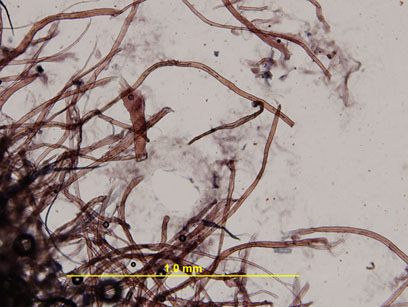Cotton
| Common Name | Cotton | Japanese Name | Men |
|---|---|---|---|
| Scientific Name |
Mavaceae Gossypium hirsutum/barbadense/arboreum |
||
| Fibre Length | Average 18mm 10-40mm | Fibre Width | Average 20μm 12-38μm |
| Fibre Ends | Usually broken | Cross-Marking | None |
| Associated Cells | None visible in this sample | ||
| Herzberg Colour | Peach/Red | Graff 'C' Colour | Peach/Red |
Notes:
The cotton fibres used in clothing and paper come from the seed hairs of one of the four sub species of Gossypium. Growing in tropical and sub-tropical regions, the plant is an annual shrub growing to between 0.5 - 1.5 metres. Traditionally cotton used in paper production was in the form of textile rags that were then processed. However, as early as 1809 experiments were taking place to use raw cotton fibres [31]. American upland cotton, G.hirsutum, makes up 90% of the worlds current cotton production. While Egyptian cotton, G. barbadense, is considered the highest quality with the longest fibre length. While Indian cotton, G. herbaceum, produces a shorter fibred, coarser cotton [14]. Cotton used in papermaking is either Cotton Lint, or Cotton Linters. While the Cotton Lint is the longer fibred cotton removed in ginning and used in textiles, Cotton Linters contain the fine, silky fibres and coarser fibres that are still attached to the seed. Within the Cotton Linters there may also be longer textile Lint fibres as well. Cotton Linters can be used to replace between 5-35% of cotton Lint in paper production without loss of strength. Cotton Lint is often processed by the Soda process, while Linters by caustic solution and bleached to remove impurities [14].
Cotton fibres are smooth, ribbon like and easily identifiable by their twisted nature. Immature fibres are often not twisted. Fibre ends are often broken, although they sometimes exhibit tapeing tips.
The sample provided was a Magnarni Pescia 100% rag cotton artists paper.
| Image 1 | Image 2 |
|---|---|
 |
 |
For information about this page, contact: Travis Taylor
Contact email address: travtora@gmail.com
Centre homepage: www.culturalconservation.unimelb.edu.au
Page last modified:
This page, its contents and style, are the responsibility of the author and do not represent the views, policies or opinions of The University of Melbourne.